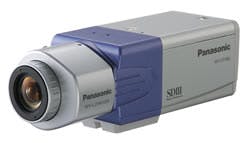Panasonic's SDIII Cameras Used at 2006 Olympic Winter Games
Secaucus, NJ - Neither bright white ski slopes washed with strong sunlight nor the reflections of artificial lighting on exterior venues will be problematic for the video surveillance cameras watching over the 2006 Olympic Winter Games in Turin, Italy. Panasonic is an official worldwide sponsor of the 2006 Olympic Winter Games and Panasonic System Solutions Company has provided more than 600 Super Dynamic III (SDIII) camera systems to monitor activity at the upcoming Olympic Winter Games.
The unique ability of these cameras to deliver clear images across a diverse range of lighting conditions assures security personnel that they will be able to clearly view all the action 24/7 during the course of the Olympic Games.
"The Panasonic SDIII cameras installed in Turin, Italy for the Olympic Games are unique because of their advanced intelligent capabilities. Their performance provides security officials with the ability to better monitor and track activities across almost any range of lighting," said Frank DeFina, President of Panasonic System Solutions Company of America (PSSA).
"The deployment of over 600 SDIII cameras will help provide an added degree of safety and security for the athletes and spectators attending this spectacular event."
Panasonic SDIII technology elevates dynamic range to 128x that of conventional cameras to capture unsurpassed image quality, even in harsh lighting conditions. Such conditions are typically experienced when outside sunlight and indoor light sources overlap - for example, when light filters through open doors, or in building lobbies with windows or glass doors - and outdoors in locations that go from daylight to the dark of night with bright headlights, reflections and street lights.
A double speed CCD with advanced Digital Signal Processing (DSP) achieves this by capturing the dark and bright portions of an image separately, and then recombining the two images into a single viewable image frame. The addition of advanced digital contrast correction further optimizes the composite image's gray scale for refined definition and balance.
SDIII's powerful intelligent processing also drives numerous unique DSP features such as Auto Back Focus, which continuously adjusts camera focus when switching from color to black-and-white operation and back again to color - automatically. This is achieved through an innovative mechanism that actually moves the position of the CCD within the camera to achieve the most accurate focus attainable in the given lighting - an industry first because the technology resides inside the camera, not in an external device.
Additional DSP advancements include Auto Image Stabilizer for camera deployment in areas that may be prone to wind and other sources of vibration; Scene Change Detection that sends an alarm when the camera's lens is obstructed or the camera angle changed without authorization; Auto Tracking to follow an individual's movements within the camera's field of view; wider bandwidth for improved resolution to 540 lines (color); 30x optical zoom (300x electronically), the highest in the industry; Adaptive Digital Noise Reduction to minimize image streaking when viewing moving images; and extreme low light sensitivity in color (0.5 lux) and BW (0.06 lux). It's a combination of performance features unique to Panasonic SDIII cameras.
"Video surveillance is a core physical security technology for large scale events like the Olympics. Panasonic Super Dynamic III cameras deliver the intelligent technology and superior image quality ideal for the diverse range of venues and lighting conditions that will be encountered throughout the course of the competition," said DeFina. "We are proud that Panasonic will play such an important role in this world-stage event."
